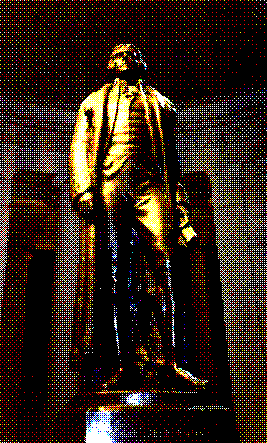New Years was usually cold. But the Fourth of July was a time to be
outside The grounds of the President's Park --cailed the "common"-- came alive at daybreak, with the raising of tents and booths soon followed by crowds of people. A regular fair was held, selling food and drink, as well as baskets, rugs, and other cottage products. There were horse races and rests of skill among the men. Cockfights and dogfights
109
took place on the sidelines. In the bare "parade" kept clear in the middle, the Washingron Militia and other military companies drilled. between ten o'clock and noon. A bareheaded Jefferson and his Cabinet watched from the steps of the White House, in civilian dress. Then the President invited everybody in to partake of his hospitality and his thanksgiving for the preservation of independence.
112
An undated drawing in lefferson's hand shows an idea for the development of the landscape, using the two wings to divide the north and south grounds, one area being private and one public. Probably drawn in 1803 or 1804, the scheme shows wings of greater extent than those finished in March 1808. Here they connect on the east and west to the executive offices, but are interrupted halfway by substantial structutes of some kind. There is little injication of what the pavilions were to be like, although their scale denotes their architectural importance.
Each pavilion is drawn in three parts within a rectangle. This reveaIs nothing about their elevations, but it may indicate that Jefferson contemplated a temple-like structure in each wing. Part of the east pavilion was built, greatly modified so that it rose onfy a small distance over the level of the terrace. It contained a guard lodge and a great arch through which the driveway passed from the sourh grounds to the north. A similar pedesrrian passage may have been planned on the west, but no part of that pavilion was ever built.
Jefferson's grounds plan descrihes his solution for reconciling the big house to its barren yard. By separating the upper and lower grounds he allowed for privacy on the south and an official entrance on the north, related to the public common. He ordered a high stone wall to be built, following the outline of the temporary rail fence around the entire perimeter of the grounds, but excluding the executive offices. Within this nearly oval enclosure Jefferson plotted on paper a landscaped park of planted trees, parterre gardens, and graveled driveways, carefully binding the house to its surroundings.
113
For the north side, the sketch shows a heavy, even planting of trees, like a thick forest or grove, cut through in three places by cleared swards that were visual extensions of the two diagonal avenues and one direct Street that led to the President's Park from the north. The axes of these avenues were carefully delineated on the topographical survey Jefferson used in making his plan. He seems to have heen adapting L'Enfant's idea for avenues directed on the palace facade like sun rays, even though his vistas were contained within his fence and did not relate to the commons or connect to the streets. On his plan the vistas -- past reflections not-withstanding -- give heightened importance to the White House over the departmental structures.
Contents | Peace Park Page
 p.108
p.108 p.108
p.108